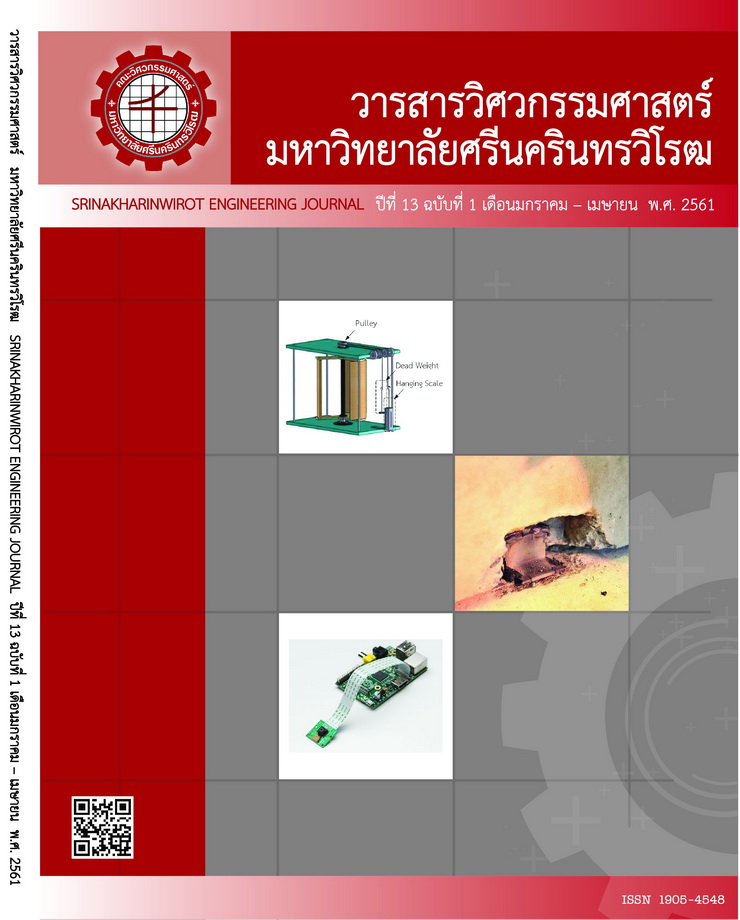Seismic Behavior of Precast Concrete Load Bearing Wall with Welded Rebar Connections
Main Article Content
Abstract
This paper presents seismic behavior of precast concrete (PC) load bearing wall panels widely constructed in Thailand through experimental and analytical programs. A quasi-static reversed cyclic loading test was conducted on an ¼ scaled PC load bearing wall panels to investigate and evaluate cyclic responses of the wall. The analytical program was verified with the experimental results using PERFORM3D. The PC wall specimen and the cast-in-situ foundation was connected using welded, short reinforcing steels. The connection was later grouted using nonshrink grout cement to achieve a structural integrity. The experimental results obviously indicated that the specimen could develop large strength and stiffness. However, after reaching its peak, the force-deformation of the wall was dramatically dropped and the specimen was failed. Analytical study also shows a good agreement with test results. The results reveal that the wall could be constructed in low seismic hazard area by considering that the walls behave within elastic range.
Article Details
Copyright belongs to Srinakharinwirot University Engineering Journal
References
[2] มาตรฐานสำหรับอาคารคอนกรีตเสริมเหล็กโดยวิธีกำลัง, มาตรฐาน วสท. 1008-38, วิศวกรรมสถานแห่งประเทศไทย ในพระบรมราชูปถัมภ์, พิมพ์ครั้งที่ 7, 2554.
[3] NEHRP (National Earthquake Hazard Reduction Program, “Recommendation provisions for seismic regulations for new buildings, Part 1 – Provisions. Building Seismic Safety Council,” Federal Emergency Management Agency, Washington, DC, USA, 1994.
[4] J. F. Hall, “Northridge Earthquake January 17, 1994 – Preliminary reconnaissance,” Earthquake Engineering Research Institute, Oakland, CA, USA, 1994.
[5] E. Yooprasertchai, I.J. Hadiwijaya, and P. Warnitchai, “Seismic performance of precast concrete rocking walls with buckling restrained braces,” Magazine of Concrete Research, vol. 68, no. 9, pp. 462-476, 2015.
[6] E. Yooprasertchai and P. Warnitchai, “An application of precast hybrid moment-resisting frames for seismic improvement,” Magazine of Concrete Research, vol.68, no. 20, pp. 1051-1069, 2016.
[7] T. Ornthammarath and P. Warnitchai, “5 May 2014 MW 6.1 Mae Lao (Northern Thailand) Earthquake: Interpretations of recorded ground motion and structural damage,” Earthquake Spectra, vol. 32, no. 2, pp. 1209-1238, 2016.
[8] G.H. Powell, “Perform-3D CSI. User Manual and User Guide,” Powell Inc., 2000.
[9] Federal Emergency Management Agency (FEMA), “Interim protocols for determining seismic performance characteristics of structural and nonstructural components through laboratory testing,” FEMA 461, 2007.
[10] Standard test methods for compressive strength of cylindrical concrete specimens, ASTM C39, 2005.
[11] Standard test methods and definitions for mechanical testing of steel products, ASTM A370, 2005.
[12] K. Orakcal, J. P. Conte, and J. W. Wallace, “Flexural modeling of reinforced concrete structural walls-model attributes,”ACI Struct. J., vol. 101, no. 5, pp. 688-698, 2004.
[13] K. Orakcal and J.W. Wallace, “Flexural modeling of reinforced concrete structural walls –experimental verification,” ACI Structural Journal, vol. 103, no. 2, pp. 196-206, 2006.
[14] Building code requirements for structural concrete (ACI 318-14) and commentary, ACI Committee, American Concrete Institute, Farmington Hills, United States, 2014.
[15] Seismic rehabilitation of existing buildings (ASCE/SEI 41-06). Reston, Virginia: American Society of Civil Engineers, 2007.
[16] T. Salonikios, I. Tegos, A. Kappos, and G. Penelis, “Squat R/C walls under inelastic shear reversals,” in Proceedings of 11th World Conference on Earthquake Engineering, Acapulco, Mexico, 1996, paper no. 749.
[17] M. Suthasit and P. Warnitchai, “Modeling of gravity load designed RC frame buildings for nonlinear dynamic analysis,” in The 14th World Conference on Earthquake Engineering, Beijing, China, 2008, paper no. 05-01-492.


